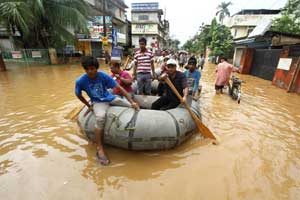Reply To:
Name - Reply Comment
Last Updated : 2024-04-24 11:56:00
 This year, not only did the monsoon reach India a few days late but its progress thereafter has been alarmingly lackadaisical. While Assam has been deluged and is reeling from the resulting floods, over 85 per cent of the country is suffering from far too little rain. The result is that the nationwide rainfall deficit stood at a grim 29 per cent at the end of June. Rainfall data for the past 140 years shows that even with a June deficit of that magnitude or greater, there is still a 60 per cent chance of the monsoon turning into a ‘normal’ one where nationwide rainfall for the season falls between 90 per cent and 110 per cent of the long-period average. The government, which has been pinning its hopes on a good monsoon to help propel economic growth, will undoubtedly be hoping for such an outcome. Even if the monsoon does turn out to be ‘normal,’ it is likely the rains will be at the lower end of that range. The probabilistic forecast in the India Meteorological Department’s updated monsoon prediction issued in late June has indicated that this is just what could happen. The forecast divides the traditional ‘normal’ range into three — ‘below normal’ (90 per cent to 96 per cent), ‘normal’ (96 per cent to 104 per cent) and ‘above normal’ (104 per cent to 110 per cent). The current monsoon has, according to the IMD, a 35 per cent chance of becoming ‘below normal,’ which is twice the climatological probability based on the outcome in past years.
This year, not only did the monsoon reach India a few days late but its progress thereafter has been alarmingly lackadaisical. While Assam has been deluged and is reeling from the resulting floods, over 85 per cent of the country is suffering from far too little rain. The result is that the nationwide rainfall deficit stood at a grim 29 per cent at the end of June. Rainfall data for the past 140 years shows that even with a June deficit of that magnitude or greater, there is still a 60 per cent chance of the monsoon turning into a ‘normal’ one where nationwide rainfall for the season falls between 90 per cent and 110 per cent of the long-period average. The government, which has been pinning its hopes on a good monsoon to help propel economic growth, will undoubtedly be hoping for such an outcome. Even if the monsoon does turn out to be ‘normal,’ it is likely the rains will be at the lower end of that range. The probabilistic forecast in the India Meteorological Department’s updated monsoon prediction issued in late June has indicated that this is just what could happen. The forecast divides the traditional ‘normal’ range into three — ‘below normal’ (90 per cent to 96 per cent), ‘normal’ (96 per cent to 104 per cent) and ‘above normal’ (104 per cent to 110 per cent). The current monsoon has, according to the IMD, a 35 per cent chance of becoming ‘below normal,’ which is twice the climatological probability based on the outcome in past years. After its poor showing in June, it is important that the monsoon revives quickly. Good rains in both July and August are essential for a ‘normal’ monsoon that is needed to sustain the Kharif crop. July will be particularly important for agriculture. As it is, the sowing of rice, coarse cereals, pulses and oilseeds have been hit. Much could depend on what happens in the Pacific Ocean. The temperature at the surface of its central and eastern tropical waters has risen. The worry is that the temperature rise might continue and result in an El Niño, which could adversely affect the monsoon. According to the IMD statistics, there have been 36 El Niño years since 1875. Of these, the nationwide monsoon rainfall was between 90 per cent and 100 per cent of the long-period average in 14 years and above 100 per cent in six years, including in 1997 that saw one of the strongest El Niños of the last century.
After its poor showing in June, it is important that the monsoon revives quickly. Good rains in both July and August are essential for a ‘normal’ monsoon that is needed to sustain the Kharif crop. July will be particularly important for agriculture. As it is, the sowing of rice, coarse cereals, pulses and oilseeds have been hit. Much could depend on what happens in the Pacific Ocean. The temperature at the surface of its central and eastern tropical waters has risen. The worry is that the temperature rise might continue and result in an El Niño, which could adversely affect the monsoon. According to the IMD statistics, there have been 36 El Niño years since 1875. Of these, the nationwide monsoon rainfall was between 90 per cent and 100 per cent of the long-period average in 14 years and above 100 per cent in six years, including in 1997 that saw one of the strongest El Niños of the last century.
Add comment
Comments will be edited (grammar, spelling and slang) and authorized at the discretion of Daily Mirror online. The website also has the right not to publish selected comments.
Reply To:
Name - Reply Comment
US authorities are currently reviewing the manifest of every cargo aboard MV
On March 26, a couple arriving from Thailand was arrested with 88 live animal
According to villagers from Naula-Moragolla out of 105 families 80 can afford
Is the situation in Sri Lanka so grim that locals harbour hope that they coul